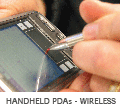Traditionally, Linux-based applications have been built using GNU tools. Even today, Bluewater uses mostly GNU tools for application development, and always for the Linux kernel. For many years, Symbian used the GNU tools also. The rationale was that GNU tools are cheap and functional, and allow access to the widest possible developer base. However, this strategy broke with companies like Nokia and Ericsson. These companies were very happy with the idea of investing significant sums of money in better tools, and regarded the use of GNU as a missed opportunity. Symbian has therefore moved to a dual approach, with serious developers using RealView and casual developers using GNU. The benefits of RealView include a better compiler (faster and smaller code, more features, better documentation) and better debugging support. Microsoft has followed a different approach with Windows CE. Microsoft uses their own compiler with a number of vendor-specific extensions, and has little interest in encouraging other tools vendors. While this approach provides a highly functional, customised and integrated IDE, it forces customers to rely on the Microsoft ARM compiler, which is not exactly the best in the world. It seems that Linux is moving to the dual-tools approach used by Symbian. This will offer the best of both worlds - low cost GNU tools and highly functional RealView tools. To illustrate the potential benefits, recently we build a bayer filter algorithm with both GNU and RealView. This was for our Bigeye Camera project. The RealView-compiled code executed in about 400ms, versus 1.7 seconds for GNU, so RealView code was 4 times faster! This is an extreme case (other results show around a 10-20% benefit) but it does illustrate the potential benefits of using RealView. A few years ago ARM introduced a --gnu flag into their RealView compiler. Using this, Bluewater Systems has written an applications note for ARM on how to build application software and libraries for Linux using RealView. Today, building Linux applications using RealView requires a fair bit of fiddling, and detailed tools knowledge. But ARM is working on this, as evidenced by the better support in each release for the last several years. The goal seems to be to replace GNU entirely in the tools chain. Bluewater uses RealView tools for bringup, debugging Linux kernels and for debugging WinCE via EXDI2. Our engineers are itching to get a better development environment (particularly in debug) than that offered by GNU. We already have a foot in the water in this area. The next major step for us will be building our Snapper-targeted OpenEmbedded release using RealView. Time frames are unclear at the moment, but even with the current RealView tools we have been able to develop a script which handles translation of most common command-line arguments. The next 12 months should see a big leap forward in Linux tools support, and resulting software performance and engineer productivity. We will keep you posted on our progress. Availability of RealView tools looks like it's becoming a key benefit of using Linux.

|
|



